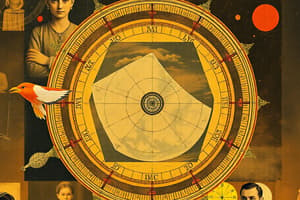Podcast
Questions and Answers
What are the two contributions that Baudhayan made to the field of Mathematics?
What are the two contributions that Baudhayan made to the field of Mathematics?
Baudhayan calculated the value of pi and discovered Pythagoras' Theorem.
Who discovered zero?
Who discovered zero?
Aryabhatta
What is the importance of Brahm Sputa Siddantika?
What is the importance of Brahm Sputa Siddantika?
The book Brahmagupta wrote, called "Brahm Sputa Siddantika", introduced negative numbers and operations on zero, making it a significant contribution to Indian mathematics, and allowed Arabs to learn about it. It became the foundation of a modern mathematical system.
Who was Kanad? How did he get his name?
Who was Kanad? How did he get his name?
Who wrote Brhat Samhita?
Who wrote Brhat Samhita?
What was Nagarjuna trying to achieve in life?
What was Nagarjuna trying to achieve in life?
What is the subject matter of Nagarjuna's treatise Rasaratnakara?
What is the subject matter of Nagarjuna's treatise Rasaratnakara?
What is Ayurveda?
What is Ayurveda?
What is the oldest book on medicine?
What is the oldest book on medicine?
What is Susruta Samhita a book on?
What is Susruta Samhita a book on?
The father of ancient Indian Medical Science is ______. He wrote the book called _______.
The father of ancient Indian Medical Science is ______. He wrote the book called _______.
What does Yoga mean?
What does Yoga mean?
Flashcards
Who was Baudhayan?
Who was Baudhayan?
The first one to calculate 'pi', a key value in calculating areas and circumferences of circles. Also, the author of 'Sulva Sutra', which contains what is now known as Pythagoras theorem.
Who was Aryabhatta?
Who was Aryabhatta?
A skilled Mathematician, Astronomer and Astrologer of Ancient India, who lived in the 5th Century. His main work was known as 'Aryabhattiya', a comprehensive text showcasing his knowledge of various fields like number theory, geometry, trigonometry, and astronomy.
Who was Brahmgupta?
Who was Brahmgupta?
A prominent Mathematician of the 7th Century. He advanced mathematics with his introduction of negative numbers and operations on zero. He pioneered the use of place values in multiplication, similar to what's used today. His work, 'Brahm Sputa Siddantika', influenced the Arabic world, spreading Indian mathematical concepts.
Who was Bhaskaracharya?
Who was Bhaskaracharya?
Signup and view all the flashcards
Who was Mahaviracharya?
Who was Mahaviracharya?
Signup and view all the flashcards
Who was Kanad?
Who was Kanad?
Signup and view all the flashcards
Who was Varahamihira?
Who was Varahamihira?
Signup and view all the flashcards
Who was Nagarjuna?
Who was Nagarjuna?
Signup and view all the flashcards
Who was Patanjali?
Who was Patanjali?
Signup and view all the flashcards
Study Notes
Scientists of Ancient India
- Ancient Indians made significant contributions to mathematics and science.
- Their contributions include advancements in mathematics, astronomy, and medicine (Ayurveda and Yoga).
- Ancient Indian mathematicians made early discoveries in areas like algebra, geometry, and trigonometry.
- Zero was not only recognized as a numeral but also as a concept.
- Ancient Indian astronomers like Aryabhata and Varahamihira made significant contributions.
- Ancient Indian medical science (Ayurveda) focused on holistic treatment of diseases.
- Patanjali developed a systematized approach to yoga.
Mathematics & Astronomy
- Ancient Indian mathematicians like Baudhayana, Aryabhata, Brahmagupta, Bhaskaracharya, and Mahaviracharya made significant contributions.
- Baudhayana's work, the Sulva Sutras, predates Pythagoras' work.
- Aryabhata, at age 23, authored the Aryabhatiya.
- Aryabhata's work included concepts of zero as a number and a concept.
- Aryabhata accurately calculated the distance between Earth and Moon
- Ancient Indian astronomers made important discoveries in understanding the movement of celestial bodies, including the rotation/revolution of the Earth.
- Astronomical observations helped create calendars, understand seasonal changes, predict tides, and conduct navigation.
Medical Science (Ayurveda & Yoga)
- Ayurveda emphasized holistic health, considering body, mind, and spirit.
- Ayurveda aimed to understand the causes of diseases.
- Treat diseases with herbal medicinal preparations.
- Susruta and Charaka were influential figures in Ayurvedic medicine.
- Yoga, an allied system to Ayurveda, focused on physical and mental well-being.
- Yoga aimed at achieving physical and mental well-being.
- Patanjali's Yoga Sutras systematized the practice of yoga.
Scientists
- Baudhayana: mathematician (Sulva Sutras)
- Aryabhata: mathematician and astronomer (Aryabhatiya)
- Brahmagupta: mathematician
- Bhaskaracharya: mathematician (Siddhantas)
- Mahaviracharya: mathematician (Ganit Sara Sangraha)
- Kanad: scientist (Vaisheshika School)
- Varahamihira: astronomer and astrologer (Brhat Samhita)
- Nagarjuna: scientist
- Susruta: surgeon
- Charaka: physician
- Patanjali: author of Yoga Sutras
Studying That Suits You
Use AI to generate personalized quizzes and flashcards to suit your learning preferences.




